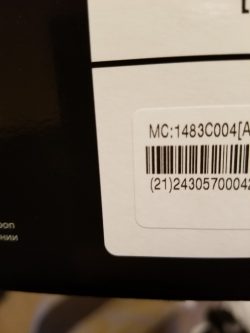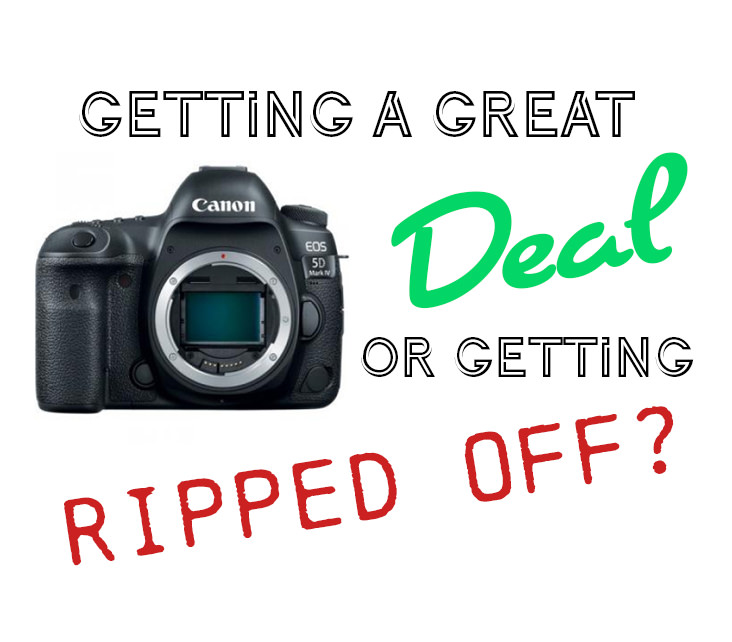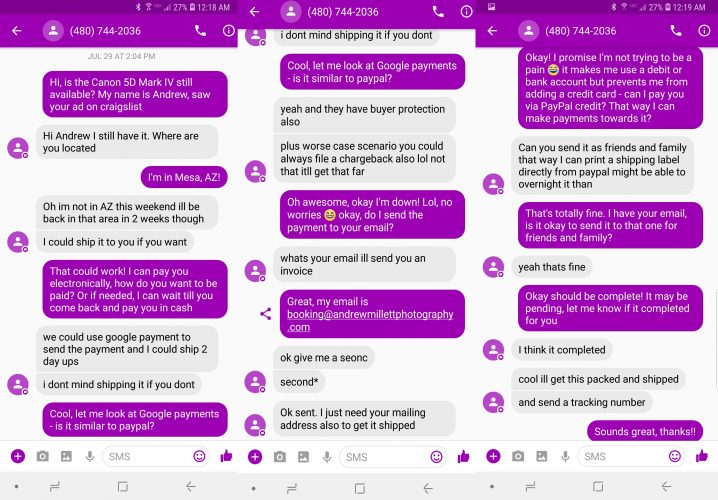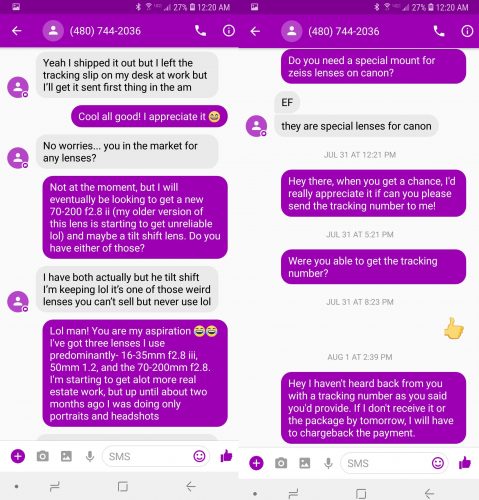There’s a new camera you’ve been wanting – maybe it’s your DREAM camera (at least for the moment!). You want a great deal and really the best possible. You’re browsing through prices and come across one that’s several hundred less…
Is it too good to be true?
Here’s three experiences I’ve had within the last year – one being horrible (but it ended up okay!), another being too good to be true and another that ended up being a fantastic deal and what I took away from these experiences.
My Very Own Craigslist Scam Experience
So, we’ve probably all heard of Craigslist scams by now and to be cautious. No checks, look for poor grammar, meet in person, inspect carefully the product as best you can etc. I was looking for good deals on used Canon 5D Mark IV and found one that had only been lightly used for $1800. The average price today (Sept 5th, 2018) is about $2700-$3000 brand new, so I thought this sounded awesome! I talked with the person, and they said they’d be back in town in a couple weeks and could show it to me then or he could mail it to me and provide me a tracking number. They also recognized it was a lot of trust to put into someone they’ve never met, and mentioned I have the fail safe of a chargeback if it didn’t work out. I recognized this as true, hoping I wouldn’t have to use it. I felt comfortable because he offered to hold it for me until he came back to Arizona and was well aware I could file a dispute through PayPal and chargeback with a card if needed. So, I took the risk and paid through PayPal!
Something Seems Amiss
He said he would send me a tracking number the following morning. I reached out the next day in the afternoon asking for it since I hadn’t heard anything. He said he shipped it out, but the tracking number was at his office and he would provide it the next day. He began to talk to me about Zeiss lenses to see if I’d like to buy any of those from him as well. During my conversation, he seemed pretty knowledgeable about camera gear and photography. I was thoroughly convinced he was legitimate. So, I gave him another day. Again, I didn’t receive the tracking information and sent another text. But this time, it went unanswered. I sent him another text that evening, and again late at night. Apparently, he was done playing and felt he got as much money as he could out of me. I texted him saying I would file a claim if he still didn’t respond, but he was steadfast in his silence. Thus, I began a dispute on PayPal and after a month, they reversed the charge on my PayPal Credit – just like he said I could! What a smarty! I was never out any money since I used PayPal Credit, and the dispute was resolved in my favor with little effort, but it tied up my PayPal Credit Line and it was a waste of my time!
Key Takeaways on Person to Person Platforms:
- Ask questions about why they’re selling the gear, how long they’ve had it, and see if you can see photos they’ve taken with it (or just their photos in general to learn more about them). This isn’t foolproof as they could try to impersonate another photographer, but should weed out most scammers who just aren’t that clever.
- Always have a financial recourse (transaction disputes and chargebacks)
- Have set expectations of when you will receive tracking information and should receive the item. If expectations are missed, you can reveal the scam sooner and begin the process of reversing the transaction.
- Get another perspective from another photographer or friend you trust to avoid falling into the trap of hoping something to be true and missing important clues.
If you’re interested, here’s our text conversation as well. He was so accommodating and friendly! Feel free to spam his number with fake requests for camera equipment.
The Gray Market
Something to always be wary of is purchasing on “The Gray Market” or unknowingly purchasing an imported version of a camera or lens. This means, it was not purchased from the manufacturer or an authorized retailer of the manufacturer. Reputable companies will tell you in the listing if it is an imported model to the US. The reason it’s important to know if the camera or lens is imported, is the warranty may not be honored in the US if the product fails. The hardware (or software if applicable) may be permanently different from the US version and accessories and the camera battery may not be from the original manufacturer.
In a nutshell, you may be lead to believe you’re buying a real, authentic camera, but it may not live up to your expectations and you may not have a recourse if something goes wrong with the product. Forbes has a great article that goes much more into detail on the “Gray Market”.
“You Probably Thought You Were Purchasing the US Version”
My first encounter with almost purchasing an imported product was looking to purchase my first full frame camera, the Canon 6D. I found it for about $900 towards the end of 2017. After submitting the purchase, the next day I received a call from a salesman of the company I had just ordered the camera. He informed me the camera I had ordered was imported from the Middle East, and would have significant differences, such as language and functionality he vaguely explained. He offered the US Version which would be a higher price (about $300 more), but was probably what I had originally thought I had ordered. After researching more online and the new price was pretty much the same as competitors, I ended up purchasing the US Version just to err on the safe side. But I was annoyed because at first I thought I was getting a great deal! Personally, I think if you’re going to take the plunge on an expensive, professional use camera, it better perform the way you want. And if you’re pursuing photography, you need gear that is reliable and let’s you focus on creating image and art, not distracting you with mechanical or software issues.
Key Takeaways on The Gray Market
- Check the listing for any clues about imported or foreign models.
- Call and ask if it isn’t clearly mentioned.
- If you decide to proceed with an imported model, know the specific differences between the US Version and the foreign version they’re selling, discover if it’s the original battery and accessories, and make sure you’re talking with someone who is familiar with the actual product by asking them specific questions about the differences in the cameras and gauging the confidence of their response.
Finally a Winner! Getting a Great Deal.
The third deal seeking experience I recently had was purchasing a Canon 5D Mark IV. I felt I could get a pretty good deal, because it has been a couple years since the camera first appeared on the market, and there’s been high demand for new cameras from competitors such as Sony and Nikon. While searching through Google on the shopping tab, I came across 4k4Less which was selling the camera for $2265.00, which was much less than the average, a savings of about $435 dollars on a brand new camera. The listing wasn’t very clear about whether it was a US Version or an imported version. I ended up purchasing it and figured if the listing was misleading or left out details, I could do a PayPal dispute or chargeback. I received it, and then confirmed with Canon’s technical support that it is indeed a US version.
How to Tell If Your Canon Camera is a US Version or Imported
The way to tell if you have an imported/gray market/foreign camera or a US version is by looking at one of the bar codes on the box. Under the bar code, there is a serial number (different from the serial number on the camera) and if there is a “21”, in parenthesis, followed by the rest of the number, that is a US version camera; complete with its own US Warranty. The number 21 is the country code Canon has assigned to the US and confirms if it is indeed a US version or for another country. So to my pleasant surprise, I had a brand new Canon 5D Mark IV for the price many photographers sell used. Great deal!!

The first two digits in parenthesis are the country code. 21 is the country code for the US.
Key Takeways on the Winner:
- Not all deals are “too good to be true”, and with the backup of a chargeback or dispute, we can take risks we otherwise would’ve stayed away from.
- We can verify (at least for Canon) if a camera is indeed a US Version through the serial number on the camera box underneath the barcode.
In Conclusion…
Do great detective work, gather as many clues as you can to know the probability of it truly being a great deal, ask questions, gauge responses, and have a fail safe in place to recoup your funds if anything goes wrong. With persistence and patience, you can get great camera gear and end up saving hundreds or thousands of dollars (depending on how much gear you buy!).
There’s a new camera you’ve been wanting – maybe it’s your DREAM camera (at least for the moment!). You want a great deal and really the best possible. You’re browsing through prices and come across one that’s several hundred less…
Is it too good to be true?
Here’s three experiences I’ve had within the last year – one being horrible (but it ended up okay!), another being too good to be true and another that ended up being a fantastic deal and what I took away from these experiences.
My Very Own Craigslist Scam Experience
So, we’ve probably all heard of Craigslist scams by now and to be cautious. No checks, look for poor grammar, meet in person, inspect carefully the product as best you can etc. I was looking for good deals on used Canon 5D Mark IV and found one that had only been lightly used for $1800. The average price today (Sept 5th, 2018) is about $2700-$3000 brand new, so I thought this sounded awesome! I talked with the person, and they said they’d be back in town in a couple weeks and could show it to me then or he could mail it to me and provide me a tracking number. They also recognized it was a lot of trust to put into someone they’ve never met, and mentioned I have the fail safe of a chargeback if it didn’t work out. I recognized this as true, hoping I wouldn’t have to use it. I felt comfortable because he offered to hold it for me until he came back to Arizona and was well aware I could file a dispute through PayPal and chargeback with a card if needed. So, I took the risk and paid through PayPal!
Something Seems Amiss
He said he would send me a tracking number the following morning. I reached out the next day in the afternoon asking for it since I hadn’t heard anything. He said he shipped it out, but the tracking number was at his office and he would provide it the next day. He began to talk to me about Zeiss lenses to see if I’d like to buy any of those from him as well. During my conversation, he seemed pretty knowledgeable about camera gear and photography. I was thoroughly convinced he was legitimate. So, I gave him another day. Again, I didn’t receive the tracking information and sent another text. But this time, it went unanswered. I sent him another text that evening, and again late at night. Apparently, he was done playing and felt he got as much money as he could out of me. I texted him saying I would file a claim if he still didn’t respond, but he was steadfast in his silence. Thus, I began a dispute on PayPal and after a month, they reversed the charge on my PayPal Credit – just like he said I could! What a smarty! I was never out any money since I used PayPal Credit, and the dispute was resolved in my favor with little effort, but it tied up my PayPal Credit Line and it was a waste of my time!
Key Takeaways on Person to Person Platforms:
- Ask questions about why they’re selling the gear, how long they’ve had it, and see if you can see photos they’ve taken with it (or just their photos in general to learn more about them). This isn’t foolproof as they could try to impersonate another photographer, but should weed out most scammers who just aren’t that clever.
- Always have a financial recourse (transaction disputes and chargebacks)
- Have set expectations of when you will receive tracking information and should receive the item. If expectations are missed, you can reveal the scam sooner and begin the process of reversing the transaction.
- Get another perspective from another photographer or friend you trust to avoid falling into the trap of hoping something to be true and missing important clues.
If you’re interested, here’s our text conversation as well. He was so accommodating and friendly! Feel free to spam his number with fake requests for camera equipment.
The Gray Market
Something to always be wary of is purchasing on “The Gray Market” or unknowingly purchasing an imported version of a camera or lens. This means, it was not purchased from the manufacturer or an authorized retailer of the manufacturer. Reputable companies will tell you in the listing if it is an imported model to the US. The reason it’s important to know if the camera or lens is imported, is the warranty may not be honored in the US if the product fails. The hardware (or software if applicable) may be permanently different from the US version and accessories and the camera battery may not be from the original manufacturer.
In a nutshell, you may be lead to believe you’re buying a real, authentic camera, but it may not live up to your expectations and you may not have a recourse if something goes wrong with the product. Forbes has a great article that goes much more into detail on the “Gray Market”.
“You Probably Thought You Were Purchasing the US Version”
My first encounter with almost purchasing an imported product was looking to purchase my first full frame camera, the Canon 6D. I found it for about $900 towards the end of 2017. After submitting the purchase, the next day I received a call from a salesman of the company I had just ordered the camera. He informed me the camera I had ordered was imported from the Middle East, and would have significant differences, such as language and functionality he vaguely explained. He offered the US Version which would be a higher price (about $300 more), but was probably what I had originally thought I had ordered. After researching more online and the new price was pretty much the same as competitors, I ended up purchasing the US Version just to err on the safe side. But I was annoyed because at first I thought I was getting a great deal! Personally, I think if you’re going to take the plunge on an expensive, professional use camera, it better perform the way you want. And if you’re pursuing photography, you need gear that is reliable and let’s you focus on creating image and art, not distracting you with mechanical or software issues.
Key Takeaways on The Gray Market
- Check the listing for any clues about imported or foreign models.
- Call and ask if it isn’t clearly mentioned.
- If you decide to proceed with an imported model, know the specific differences between the US Version and the foreign version they’re selling, discover if it’s the original battery and accessories, and make sure you’re talking with someone who is familiar with the actual product by asking them specific questions about the differences in the cameras and gauging the confidence of their response.
Finally a Winner! Getting a Great Deal.
The third deal seeking experience I recently had was purchasing a Canon 5D Mark IV. I felt I could get a pretty good deal, because it has been a couple years since the camera first appeared on the market, and there’s been high demand for new cameras from competitors such as Sony and Nikon. While searching through Google on the shopping tab, I came across 4k4Less which was selling the camera for $2265.00, which was much less than the average, a savings of about $435 dollars on a brand new camera. The listing wasn’t very clear about whether it was a US Version or an imported version. I ended up purchasing it and figured if the listing was misleading or left out details, I could do a PayPal dispute or chargeback. I received it, and then confirmed with Canon’s technical support that it is indeed a US version.
How to Tell If Your Canon Camera is a US Version or Imported
The way to tell if you have an imported/gray market/foreign camera or a US version is by looking at one of the bar codes on the box. Under the bar code, there is a serial number (different from the serial number on the camera) and if there is a “21”, in parenthesis, followed by the rest of the number, that is a US version camera; complete with its own US Warranty. The number 21 is the country code Canon has assigned to the US and confirms if it is indeed a US version or for another country. So to my pleasant surprise, I had a brand new Canon 5D Mark IV for the price many photographers sell used. Great deal!!

The first two digits in parenthesis are the country code. 21 is the country code for the US.
Key Takeways on the Winner:
- Not all deals are “too good to be true”, and with the backup of a chargeback or dispute, we can take risks we otherwise would’ve stayed away from.
- We can verify (at least for Canon) if a camera is indeed a US Version through the serial number on the camera box underneath the barcode.
In Conclusion…
Do great detective work, gather as many clues as you can to know the probability of it truly being a great deal, ask questions, gauge responses, and have a fail safe in place to recoup your funds if anything goes wrong. With persistence and patience, you can get great camera gear and end up saving hundreds or thousands of dollars (depending on how much gear you buy!).



What an enlightening article. I’m looking at buying a Nikon 7500. Any idea what the American country code is for that?
I was originally looking at buying from 4k4less but I’ve read a lot of bad reviews. You seem to have had a good experience with them though. I’m now on the fence. Whatever my decision, I intend to follow your advice. However, I’m curious if you have any further opinions on them or those reviews. Thank you.
Do you have any